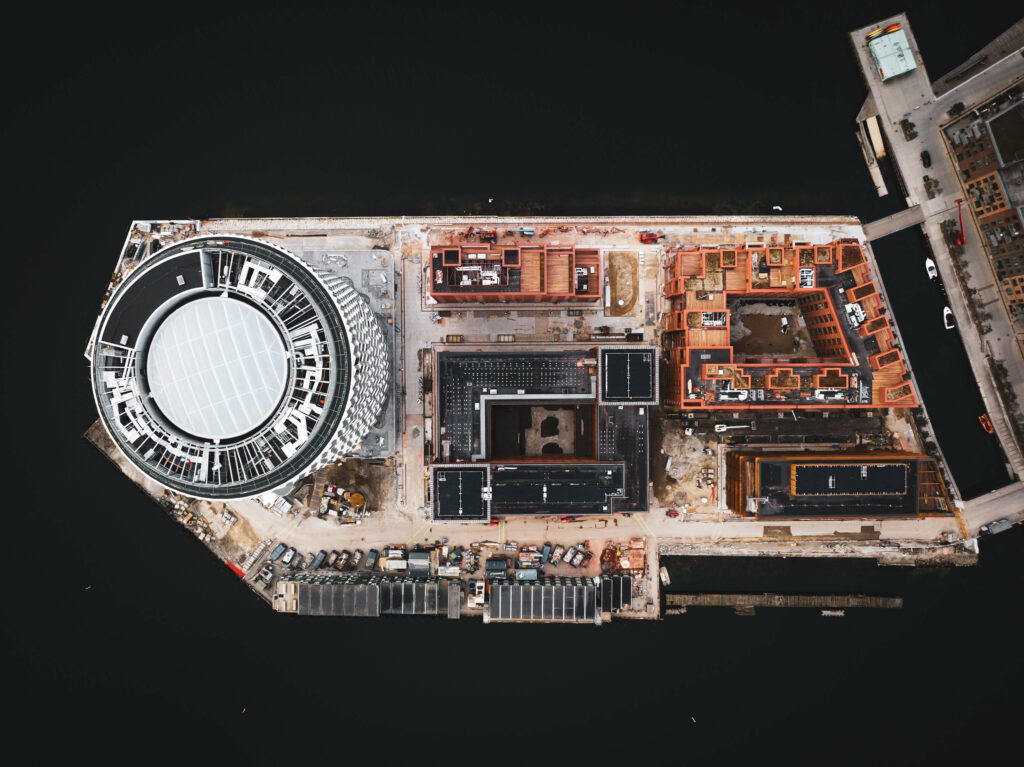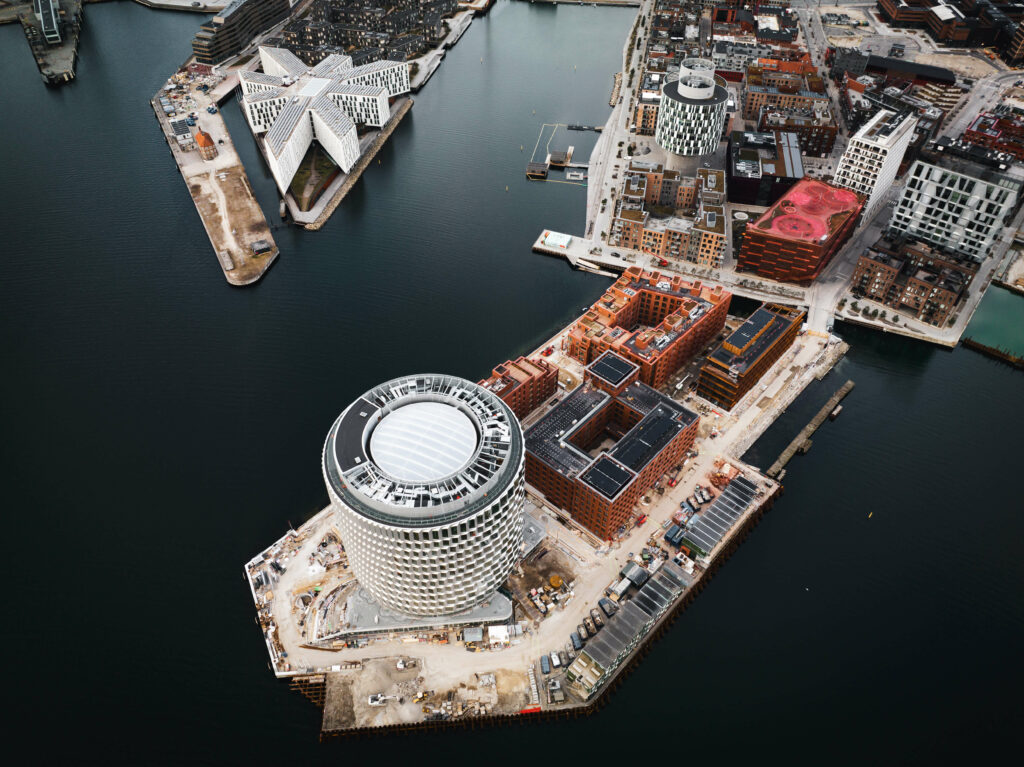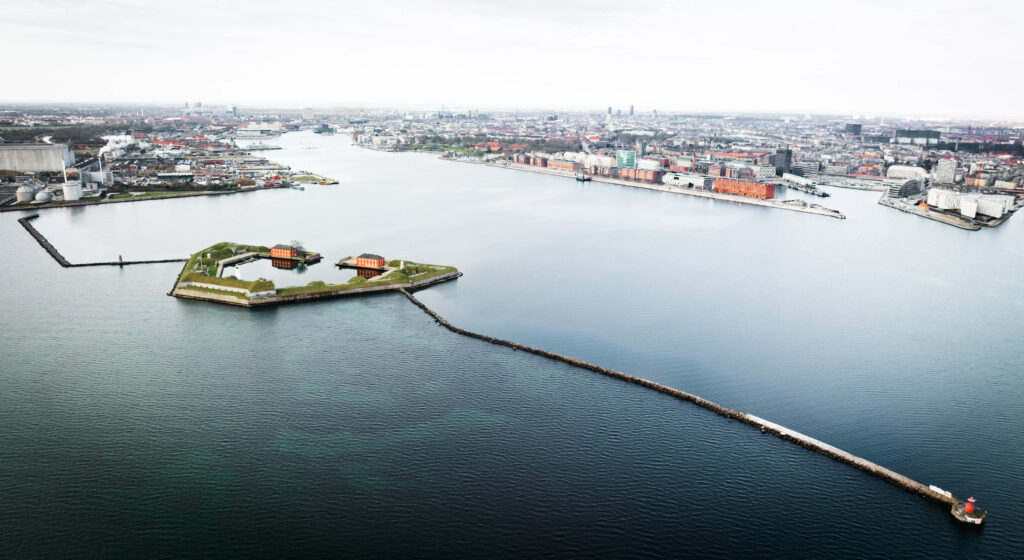Denmark, Copenhagen: Addressing the challenges of climate change and urbanization through land reclamation.
Early morning aerial photographs taken by drone photographer Superfly Ireland have revealed Denmark’s impressive land reclamation project around the Copenhagen harbor. The project, which aims to create more space for schools, apartments, and recreational areas, is a shining example of urban planning that prioritizes the needs of the community.
The process of reclaiming land is not new, and has been utilized in various countries across the world for centuries. It involves creating new land from bodies of water, such as seas, rivers, and lakes, through the use of various techniques, including dredging and poldering. Land reclamation projects are often undertaken to expand cities, build ports, or create new agricultural land.

The positives of land reclamation projects are numerous. Firstly, they provide a solution to the problem of limited space in densely populated areas. Reclaimed land can be used to build schools, hospitals, housing, and recreational areas, all of which contribute to a better quality of life for citizens. Additionally, reclamation projects can help protect low-lying coastal areas from the effects of rising sea levels and storm surges.
However, there are also negatives associated with land reclamation. One of the main concerns is the environmental impact of the process. Dredging and poldering can result in the destruction of marine habitats, loss of biodiversity, and pollution of the surrounding waters. Additionally, land reclamation projects can be expensive and can take several years to complete.

Despite these challenges, Denmark has been able to successfully reclaim land around the Copenhagen harbor for public use. The Danish government has invested heavily in the project, utilizing a combination of public and private funds to finance it. The cost of land reclamation varies depending on the size of the project, the techniques used, and the location. In Denmark, the cost has been estimated at around €1.5 billion for the entire project.
The project aims to create a new district called “Nordhavn” which will be an extension of the existing Østerbro district. The new district will cover an area of approximately 370 hectares, and will be able to accommodate 40,000 residents and provide 40,000 jobs.
- The Nordhavn district will include a mix of residential, commercial, and public spaces. It will have about 8,000 residential units, with a mix of private and social housing. In addition, the district will have several new schools, parks, cultural centers, and other community facilities.
The district will also be designed to be environmentally sustainable, with a focus on reducing carbon emissions and improving energy efficiency. It will feature a district heating system, which will provide heat to buildings through a network of pipes, and a district cooling system, which will use seawater to cool buildings in the summer months. The district will also have a rainwater management system that will help reduce the risk of flooding.

The construction of the Nordhavn district is expected to be completed in several phases, with the first phase already underway. The first phase of the project, which covers an area of approximately 115 hectares, is expected to be completed in 2027. The entire project is estimated to cost around $1.5 billion, with funding coming from a combination of public and private sources.
Overall, the creation of the Nordhavn district through the land reclamation project around the Copenhagen harbor represents an ambitious and forward-thinking urban planning initiative. By creating a new sustainable district that is designed to meet the needs of its residents, Copenhagen is setting an example for other cities around the world to follow
In addition to the new district being created through the land reclamation project around the Copenhagen harbor, there is also a new sea wall being constructed as part of the project.
The sea wall is being built to protect the new district from rising sea levels and storm surges, which are expected to become more frequent and severe due to climate change. The sea wall is being designed to withstand high waves and winds, and to minimize the risk of flooding.
The construction of the sea wall involves a combination of techniques, including the use of concrete blocks and geotextile fabric. The concrete blocks are being placed at the bottom of the harbor, while the geotextile fabric is being placed on top of the blocks to create a barrier that can absorb wave energy and reduce the risk of erosion.

The sea wall is not the only measure being taken to protect the new district from flooding. The land reclamation itself is also designed to help reduce the risk of flooding. By creating new land from the harbor, the project is reducing the amount of open water that is exposed to storms and waves. Additionally, the new land is being raised to a height that is above the projected sea level rise, further reducing the risk of flooding.
Overall, the new sea wall and land reclamation at the Copenhagen harbor represent a comprehensive approach to addressing the challenges of climate change and urbanization. By creating a new district that is both sustainable and resilient, Copenhagen is setting an example for other cities around the world to follow.

Denmark has a long history of land reclamation, with some of the earliest recorded reclamation projects dating back to the Middle Ages. The country’s success in this area is due in part to its geography – Denmark is a small, low-lying country with a long coastline, which has necessitated the need for land reclamation for centuries.
In addition to its geography, Denmark has also developed a strong expertise in the field of land reclamation through a combination of research, innovation, and collaboration between government, industry, and academia. The Danish government has provided funding and support for research into new techniques and technologies for land reclamation, and has also established regulations and guidelines to ensure that the process is carried out in an environmentally sustainable and socially responsible way.
One of the most significant contributors to the development of modern land reclamation techniques was a Dutch engineer named Cornelius Vermuyden, who was invited to England in the 17th century to help drain the fens in East Anglia. Vermuyden’s methods involved the construction of drainage channels and embankments, which allowed the land to be drained and reclaimed for agricultural use. His work paved the way for modern land reclamation techniques, which have been adapted and refined over the centuries.
Overall, Denmark’s success in land reclamation is the result of a combination of factors, including its geography, government support, and a long history of expertise and innovation in the field.
References
“Copenhagen’s harbour is being redeveloped to make way for 2km of housing, offices, shops and public spaces” – Dezeen
“Denmark: Copenhagen’s harbor reclamation project begins” – Construction Review Online
“Copenhagen’s harbor is being transformed into a new city district with 40,000 residents” – Nordic Business Insider
